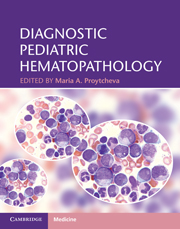Book contents
- Frontmatter
- Contents
- List of contributors
- Acknowledgements
- Introduction
- Section 1 General and non-neoplastic hematopathology
- 1 Hematologic values in the healthy fetus, neonate, and child
- 2 Normal bone marrow
- 3 Disorders of erythrocyte production
- 4 Disorders of hemoglobin synthesis
- 5 Hemolytic anemias
- 6 Inherited and acquired bone marrow failure syndromes associated with multiple cytopenias
- 7 Inherited bone marrow failure syndromes and acquired disorders associated with single peripheral blood cytopenia
- 8 Peripheral blood and bone marrow manifestations of metabolic storage diseases
- 9 Reactive lymphadenopathies
- Section 2 Neoplastic hematopathology
- Index
- References
7 - Inherited bone marrow failure syndromes and acquired disorders associated with single peripheral blood cytopenia
Pure red cell aplasia, agranulocytosis, and thrombocytopenias
from Section 1 - General and non-neoplastic hematopathology
Published online by Cambridge University Press: 03 May 2011
- Frontmatter
- Contents
- List of contributors
- Acknowledgements
- Introduction
- Section 1 General and non-neoplastic hematopathology
- 1 Hematologic values in the healthy fetus, neonate, and child
- 2 Normal bone marrow
- 3 Disorders of erythrocyte production
- 4 Disorders of hemoglobin synthesis
- 5 Hemolytic anemias
- 6 Inherited and acquired bone marrow failure syndromes associated with multiple cytopenias
- 7 Inherited bone marrow failure syndromes and acquired disorders associated with single peripheral blood cytopenia
- 8 Peripheral blood and bone marrow manifestations of metabolic storage diseases
- 9 Reactive lymphadenopathies
- Section 2 Neoplastic hematopathology
- Index
- References
Summary
Congenital anemias due to impaired red cell production
Congenital anemias are a heterogeneous group of rare disorders due to impaired red cell production, resulting from either pure red cell aplasias and lack of erythroid progenitors in the marrow, or from ineffective erythropoiesis, dyserythropoiesis, and an increased cell death (Table 7.1). Either pathogenic mechanism leads to a variable degree of anemia with a low reticulocyte count. The peripheral blood findings are non-specific, and the diagnosis requires a bone marrow evaluation and ancillary studies. Anemias due to hemoglobinopathy, nutritional deficiency, increased red cell destruction, or bone marrow metastases are discussed in other chapters.
Diamond–Blackfan anemia [Online Mendelian Inheritance in Man (OMIM) 105650]
Epidemiology and clinical presentation
Diamond–Blackfan anemia (DBA), also known as congenital hypoplastic anemia, is a clinically and genetically heterogeneous group of disorders manifested in early infancy with anemia and reticulocytopenia due to absolute erythroid hypoplasia in otherwise normocellular bone marrow (BM). DBA is the first and, so far, the only known disease of abnormal ribosome biogenesis. It is characterized by mutations at structural ribosomal proteins, which result in intrinsic disorders of erythropoiesis, congenital anomalies, and an increased predisposition to malignancies [1, 2].
- Type
- Chapter
- Information
- Diagnostic Pediatric Hematopathology , pp. 104 - 134Publisher: Cambridge University PressPrint publication year: 2011



